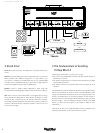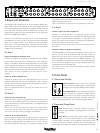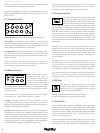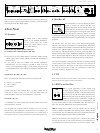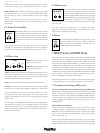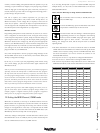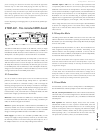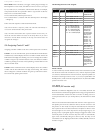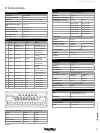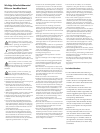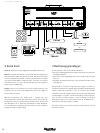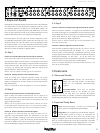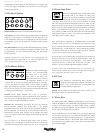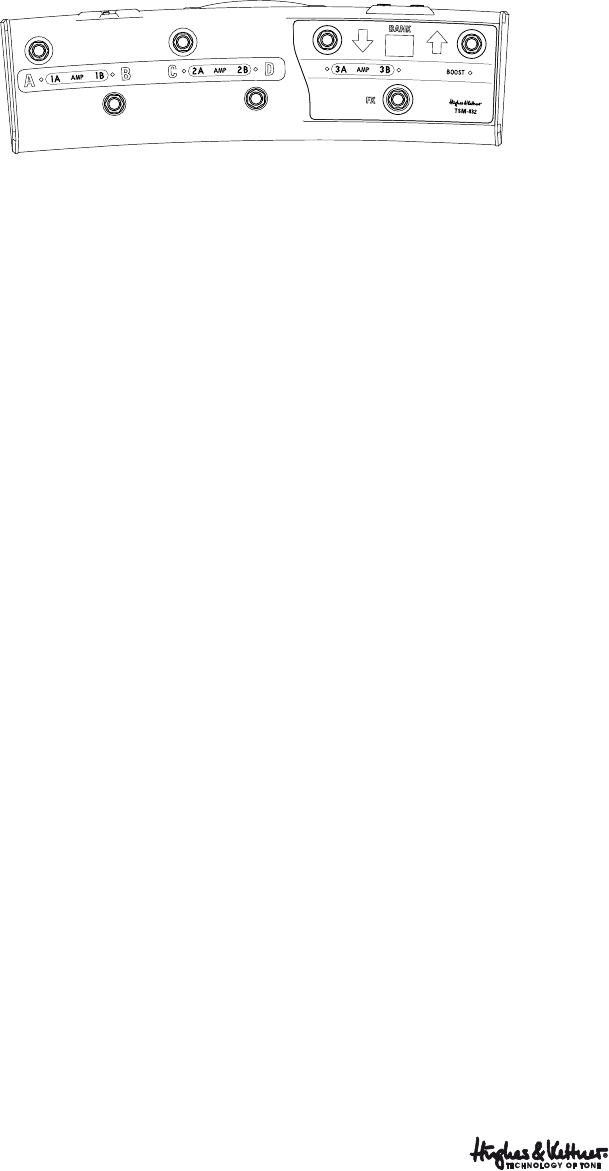
11
TriAmp Mark 3 – Manual 1.0b
you’re not using) are shut down. The LEDs only indicate the right status
when the amp is in idle mode. While playing, the LEDs may flash very
occasionally, but this has no effect over the amp or the tubes in operation.
If you do ever swap one tube from a pair, make sure that the replacement
tube’s rating matches that of its counterpart. You can buy replacement
tubes from any good local music store, and please note that you do not
necessarily have to use tubes from Hughes & Kettner!
Caution: Replacing or exchanging tubes is a job best left to qualified pro-
fessionals!
9 TSM-432 - The included MIDI board
The TSM-432 MIDI board is based on the FSM-432, which you might
already know from the Hughes & Kettner SwitchBlade, CoreBlade or
GrandMeister models. Should you have an FSM-432, you can use it with
TriAmp Mark 3 to select presets in case the TSM-432 is not available.
The TSM-432 is tailored specifically to TriAmp Mark 3, and offers two
modes: Stomp Box Mode and Preset Mode. In Stomp Box mode, the
TSM-432’s buttons serve to access the amp’s six channels and to switch
the Stomp Boost directly. In Preset Mode, the TSM-432 gives you access
to 128 MIDI presets. We recommend you start in Stomp Box mode first,
and get to know TriAmp Mark 3 in basic terms before you move on to the
vast opportunities the world of MIDI presets offers!
9.1 Connections
You do not need an external power source for the TSM-432, because
phantom power is provided through TriAmp Mark 3’s 7-pin MIDI In
socket. If the TSM-432 is connected correctly, it will run through the
following starting sequence once the TriAmp is switched on: the display
will show the version number, and all the LEDs will light up from left to
right. After this, the display will either change to ‘1’, if the TSM-432 is
in Preset Mode, or ‘Sb’, if the TSM-432 is in Stomp Box Mode. The LED
below button A lights up continuously in both modes.
MIDI Out: Connect the TSM-432’s MIDI Out to TriAmp Mark 3’s MIDI
In with the included 7-pin MIDI cable. If you are using a standard 5-pin
cable, see the Power Supply section below.
MIDI In: To operate TriAmp Mark 3 with the TSM-432, the MIDI In is not
necessarily needed. You can also use the MIDI In to connect other MIDI
devices to the TSM-432. In this case, the TSM-432 serves as a true MIDI
merger, forwarding the MIDI information from MIDI In to MIDI Out.
Power Supply: If you wish to use a standard 5-pin MIDI cable, you will
need a power supply. To help connectivity wherever you are in the world,
the TSM-432 provides an innovative mains port that accepts any AC or
DC adapter rated for 9 to 15 volts and providing at least 250 mA.
Controller Inputs 1 and 2: You can connect single footswitches and/
or expression pedals to these two 6.3 mm (1/4") jack inputs and assign
additional control functions for TriAmp Mark 3. All of the amp’s buttons
can be remote controlled by a single footswitch, and the illumination of
the front panel can be switched on or off. The brightness of the panel
illumination can even be controlled using an expression pedal! This
might be more of a gimmick than a genuine feature, but we had loads of
requests from TriAmp players, so we thought… well, why not?! Let’s do it!
How to assign functions to the various control inputs is described below
(in Section 9.4: Assigning Control 1 and 2).The factory setting for both
inputs is set to switch the Noise Gate (Control 1) and the FX Loop On/
Off (Control 2).
9.2 Stomp Box Mode
The sliding switch above the MIDI connections on the rear side of the
TSM-432 determines if the board is operating in Preset Mode or Stomp
Box Mode. If you move the sliding switch to Stomp Box Mode, the display
shows an ‘Sb’ symbol.
In Stomp Box Mode, the six buttons (1A, 1B, 2A, 2B, 3A and 3B) are now
firmly assigned to TriAmp Mark 3’s six channels. The lettering on the
TSM-432 relates to the three preamps (numbered 1,2 and 3) with two
channels each (A/B). In addition, the Stomp Boost can be independently
activated and deactivated at the push of a button.
Note: The LEDs above/below their respective buttons do not always in-
dicate the selected channel and status of the Stomp Boost. If you select
channels or activate Boost manually on the amp, the TSM-432 does not
recognize the changes!
Tip: You can also access the Stomp Box Mode on the fly when you are
in Preset Mode. Press and hold the FX and B buttons to change over to
Stomp Box Mode. To return to Preset Mode, press and hold FX and B
again. This is a temporary function: TSM-432 automatically reverts to the
mode that is selected by the sliding switch when powered off.
9.3 Preset Mode
In Preset Mode, you have access to TriAmp Mark 3’s 128 MIDI presets.
See the MIDI Presets and Setup Chapter to learn more about presets.
The A, B, C and D preset buttons: Presets within a bank activate directly.
This means that you can switch straight from A to B within the same bank.
The LEDs above/below the respective A, B, C, and D buttons indicate the
selected preset.
Bank Up/Down: The TSM-432’s display always shows the currently
selected bank number. To access a preset in another bank, select the
target bank using the Up and Down buttons. You can continue playing
with the current preset while you’re navigating. The TSM-432’s display
shows the bank’s number; it flashes until you select a preset in the target
bank by pressing A, B, C, or D. The TSM-432 will not switch over to the
new preset until you do this, unless you activate Direct Mode.
• English • Deutsch




